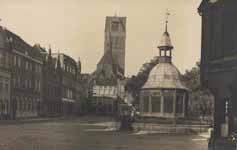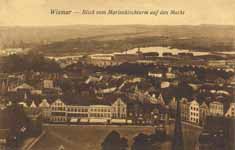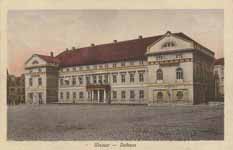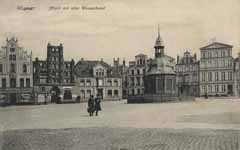.







7,
Wismar
Wismar (German pronunciation: [ˈvɪsmaʁ]), is a small port and Hanseatic League town in northern Germany on the Baltic Sea, in the state of Mecklenburg-Vorpommern, about 45 km due east of Lübeck, and 30 km due north of Schwerin. Its natural harbour, located in the Bay of Wismar is well-protected by a promontory. The population was 45,414 in March 2005, more than doubled from 21,902 in 1905. A former district-free town, it is the capital of the district of Nordwestmecklenburg since the September 2011 district reforms.
Representative of Hanseatic League city brick construction as well as the German brick churches, the city has been included in the UNESCO list of World Heritage Sites since 2002.
The town was the setting of the 1922 vampire movie Nosferatu (in the film however, the town is named "Wisborg").
History
Wassertor (Water Gate)
view to the old water tower
Founded by the Polabians as Vishemir[2] and later settled by the Germans, Wismar is said to have received its civic rights in 1229, and came into the possession of Mecklenburg in 1301. In 1259 it had entered a pact with Lübeck and Rostock, in order to defend itself against the numerous Baltic sea pirates. This developed into the Hanseatic League. During the 13th and 14th centuries it was a flourishing Hanseatic town, with important woollen factories. Though a plague carried off 10,000 of the inhabitants in 1376, the town seems to have remained tolerably prosperous until the 16th century.
Under Swedish rule
Under the Peace of Westphalia in 1648 Wismar passed into the possession of Sweden, with a ruling house from which it acquired its name. Through Wismar and the other dominions in the Holy Roman Empire, the Swedish monarchs in their roles as princes, or Reichsfürsten, took part in the Imperial Diets. From 1653 it was the seat of the highest court for that part of Sweden. In 1803 Sweden pledged both town and lordship to Mecklenburg for 1,258,000 Riksdaler, reserving, however, the right of redemption after 100 years. In view of this contingent right of Sweden, Wismar was not represented at the diet of Mecklenburg until 1897. In 1903 Sweden finally renounced its claims on the town. Wismar still retains a few relics of its old liberties, including the right to fly its own flag.
Modern times
Boroughs of Wismar
At the turn of the 19th century the most important manufacturing industries of Wismar were iron, machinery, paper, roofing-felt and asphalt. There was also considerable trade, especially by sea, in exports including grain, oil-seeds and butter, and the imports coal, timber and iron. The harbour was deep enough to admit vessels of 5 m draught, and permitting large steamers to unload along its quays. Wismar was the location of the Norddeutsche Dornier-Werke aviation plant and railway - factories. Throughout World War II Wismar was heavily damaged by Allied air raids. At the end of the war in Europe, as the Line of contact between Soviet and other Allied armies formed, Wismar was captured by British and Canadian Forces on May 2, 1945. On July 1, 1945, due to the agreements of the Yalta Conference making Wismar a part of the Soviet Occupation Zone of Germany, the British troops departed as Soviet troops entered.
Main sights
The centre of the old town is the huge Market Place, the largest in Germany (10,000 square metres), surrounded by elegant buildings with styles ranging from 14th-century North German Gothic to 19th-century Romanesque revival. The square's focal point is the Wasserkunst, an elaborate wrought-iron fountain imported from Holland in 1602. The northern side of the square is occupied by the Town Hall, built in neoclassical style in 1817–1819. Another notable building in the square is an ancient Gothic warehouse called Alter Schwede (The Old Swede), erected around 1380.
The 80 m high tower church of St Mary (Marienkirche) is the only remainder of the original Brick Gothic edifice, built in the first half of the 13th century. It suffered heavy damage in World War II, and was deliberately destroyed in 1960 under the East German Communist government.
The church of St Nicholas (Nikolaikirche), built in 1381–1460, with very lofty vaulting, together with the Marienkirche, are regarded as good examples of the influence exercised in these northern provinces by the large church of St Mary in Lübeck.
The elegant cruciform church of St George (St Georgen-Kirche) dates from the first half of the 13th century. It was heavily damaged in World War II and repaired during 1990-2010.
The Fürstenhof, at one time a ducal residence, and later occupied by the municipal authorities, is a richly decorated specimen of the Italian early Renaissance style. Built in 1552–1565, it was restored in 1877–1879. The "Old School", dating from about 1300, has been restored. The town hall, rebuilt in 1829, contains a collection of pictures. The main gallery for fine arts is the Municipal Gallery "Baumhaus" located in the old harbour area of Wismar.
Notable people from Wismar
Klaus Störtebeker (c.1360-1401), privateer
Sophie of Mecklenburg-Güstrow (1557–1631), queen of Denmark
Bernhard Latomus (1560–1613), historian
Daniel Georg Morhof (1639–1691), historian
Joachim Gerstenbüttel (c1650-1721), composer
Johan Carl Wilcke (1732–1796), physicist.
Friedrich Christoph Dahlmann (1785–1860), historian, statesman
Friedrich Bernhard Christian Maassen (1823–1900), law professor
Gottlob Frege (1848–1925), mathematician, philosopher, logician
Marie Musaeus Higgins (1855–1926), founder of Musaeus College, Colombo
Wilhelm Müller-Wismar (1881–1916), ethnographer and traveler
Joachim Streich (b. 1951), former East German footballer
References
^ "Bevölkerungsstand der Kreise, Ämter und Gemeinden in Mecklenburg-Vorpommern 31.12.2010" (in German). Statistisches Amt Mecklenburg-Vorpommern. 6 July 2011.
^ The Great Soviet Encyclopedia (1979), V. 5
Chisholm, Hugh, ed. (1911). "Wismar". Encyclopædia Britannica (11th ed.). Cambridge University Press.
From Wikipedia, All text is available under the terms of the GNU Free Documentation License
